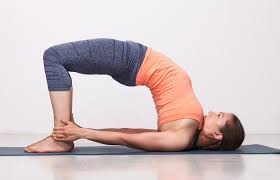Reclining twist
The reclining twist stretches the whole spine. Lie on your back, knees bent and feet on the floor near the pelvis. The arms are extended from the shoulders, palms down. Cross the right thigh over the left, wrapping the legs tightly (if possible, catch the left shin with the toes of the right foot). Now lift the pelvis off the floor momentarily, sliding the left hip underneath and toward the center. Then lower the pelvis, twist to the left, and let the wrapped legs release toward the floor.
If you are very flexible you may be able to keep both the legs and the right arm and shoulder on the floor at the same time. For most people, however, the pose evolves over many practice sessions by alternately working with the twist in the lower torso (keeping the shoulder and arm firmly anchored) and then the twist in the upper torso (allowing the shoulder and arm to initially release from the floor and then drawing them back). Whichever alternative you have chosen, breathe deeply into the abdomen as you centre yourself in the pose. When you are ready, return to the center and repeat on the other side.
Stretching and opening
To perform the stretch correctly, bend your elbows and interlace your fingers behind you, separating the palms of your hands. Keeping the elbows bent, lift and square your shoulders; then draw your shoulders back, moving your elbows toward each other so that your upper arms are parallel.
Fish pose
Lie on your back on the floor. Inhale, slowly tilt your head backwards until the back is arched and the crown of the head touches the floor. The forearms and elbows can be used as support to assume the posture. Breathing should be even. Hold this position for 2-5 minutes and relax.
Standing stretch
This stretch addresses some of the deepest levels of tightness in the arm, shoulder and chest. Stand next to a wall with your feet parallel and comfortably separated. Place the fingerprints of one hand on the wall at shoulder height with your arm fully extended. Place your other hand on your hip. Cup your fingers so that only the fingertips touch the wall, and rotate your arm outward slightly so that your thumb (rather than your index finger) points upward. Keep your shoulder aligned with your hand and begin to lift and open your chest with your breath, rolling your collarbones back.
Now, twisting from the waist, turn through your arm to the fingertips, as if the wall were moving away from you.



 Contact Us
Contact Us

 Hospitals
Hospitals
 Doctors
Doctors
 Diagnostic
Diagnostic
 Pharmacy
Pharmacy
 Health Tips
Health Tips
 Blog
Blog

















